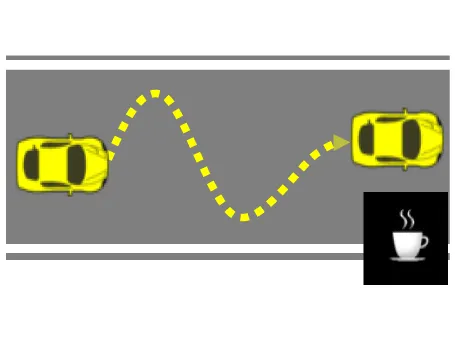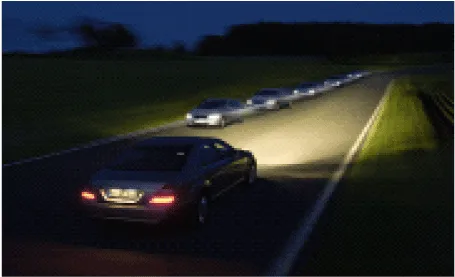Hyundai Palisade (LX2): Front View Camera System / Description and operation
| Description and Operation |
|
|
The System may be limited when :
|
| • |
The radar sensor or camera is blocked with a foreign object or debris.
|
| • |
The camera lens is contaminated due to tinted filmed or coated windshield,
damaged glass, or stuck of foreign matter (sticker, bug, etc.) on the
glass.
|
| • |
Inclement weather such as heavy rain or snow obscures the field of view
of the radar sensor or camera.
|
| • |
The target in front is too small to be detected
|
| • |
The vehicle in front is an oversize vehicle or trailer that is too big
to be detected by the camera recognition system (for example a tractor
trailer, etc.).
|
| • |
The camera's field of view is not well illuminated (either too dark
or too much reflection or too much backlight that obscures the field
of view)
|
| • |
The vehicle in front does not have their rear lights ON or their rear
lights are located in an unsual location (modified).
|
| • |
The windshield glass is fogged up and the clear view of the road has
been obstructed.
|
| 1. |
Forward Collision-Avoidance Assist (FCA): This driving safety system
sends warning to the driver for possible dangers and assists the braking
of the vehicle to help avoid collision with any kind of obstacles that
are in front of the car while driving. The FCA recognizes the position
and the speed of the front obstacles (vehicle / pedestrian / two-wheeled
vehicle) using the front camera / forward radar, sends visual / audible
warning to the driver when a collision with the front obstacle is expected
and helps the driver to avoid the collision by assisting to control
the brake. However, the driver must keep an eye on the forward for safety
because the front camera / forward radar may not operate normally in
certain situations where the obstacles cannot be easily recognized.
|
| 2. |
Lane Keeping Assist (LKA): This driving safety system sends warning
to the driver for possible dangers and controls the steering wheel when
the system judges that the car is off the lane , reducing the risk of
getting into an accident while driving. The LKA sends the driver the
visual / audible / tactical warning by using the data about lanes, which
is obtained by the front camera, the operational status of the turn
signal lights, and helps the driver to avoid the collision by assisting
to control the steering wheel. However, the front camera may not operate
normally in certain situations where the locations or the boundaries
of the lanes are hard to be identified.
|
| 3. |
Driver Attention Warning (DAW): This system warns the driver to avoid
accidents if it judges that the driver is driving inadvertently. The
DAW sends the driver visual and audible warnings if an inadvertent driving
is detected by analyzing the driving pattern of the driver in consideration
of the lane condition recognized by the front camera and the data on
the speed / steering wheel angle / brake operation of the vehicle. However,
the front camera may not operate normally in certain situations where
the camera fails to obtain data about surroundings.
|
| 4. |
High Beam Assist (HBA): This system controls the operation of high beam
to improve sight distance as much as possible by minimizing glare from
other vehicles when driving at night or with no or less light. By using
a forward camera, the HBA identifies where the light comes from, (whether
it is from a vehicle in the front / across or a street). When there
is light, the system turns the high beam OFF and when there is no light,
it turns the high beam ON. However, the front camera may not operate
normally in certain situations where the camera fails to obtain data
about surroundings.
|
| 5. |
Highway Driving Assist (HDA): This system is a driving convenience system
that reduces driver burden while driving on highway or motorway by controlling
the vehicle’s steering, acceleration and deceleration to maintain the
speed set by the driver, keep a safe distance from the vehicle directly
ahead, and keep the vehicle in the center of its current lane.
HDA uses navigational information to determine whether the vehicle is
on highway or motorway. When the vehicle is on highway or motorway,
HDA maintains the central position in the lane and the safe distance
from the vehicle ahead by controlling steering and acceleration/deceleration
in consideration of the lane information detected by the front camera
and the relative position/speed detected by the front camera/radar from
the vehicle ahead.
HDA is canceled when a driver presses the LFA button or SCC button or
applies brake.
Also, HDA alerts the driver with visual/audible warnings when it judges
that driver takes hands off the steering wheel for more than certain
time and if the driver still does not hold the steering wheel after
the hands-off warning, HDA will be canceled.
|
|
|
|
Warning [km/h] |
FULL Braking [km/h] |
|
Camera FCA |
Stationary |
10 - 180 |
10 - 60 |
|
Moving vehicle |
30 - 180 |
30 - 60 |
|
|
Pedestrians |
10 - 60 |
10 - 60 |
|
System |
Start [km/h] |
Stop [km/h] |
||
|
MIN |
MAX |
MIN |
MAX |
|
|
LKA |
65 |
200 |
55 |
210 |
|
DAW |
- |
175 |
- |
180 |
|
HBA |
40 |
175 |
30 |
180 |
| 1. |
FCA, Forward Collision-Avoidance Assist :
|
| 2. |
LKA, Lane Keeping Assist :
|
| 3. |
DAW, Driver Attention Warning :
Inadvertent driving warning
Front Vehicle Departure Warning
|
| 4. |
HBA, High Beam Assist :
|
Components Location 1. Front camera 2. Cluster 3. LKA ON/OFF switch
Variant Coding When you need variant coding: – Replace Front View Camera with a new one ※ EOL Variant Coding and calibration required for new replacement Front View Camera Variant Coding Front view camera variant coding makes it possible to operate functions for each vehicle type.
Other information:
Hyundai Palisade (LX2) 2020-2025 Service Manual: Wireless Charging Lamp
Components and positions Components Repair procedures Removal Handling wireless charging system parts by wet hands may cause electric shock.
Hyundai Palisade (LX2) 2020-2025 Service Manual: Heater & A/C Control Unit (Rear)
Components and components location Component Connector Pin Function Connector PIN No Pin Function Connector PIN No Pin Function A 1 Battery A 17 IGN2 2
Categories
- Manuals Home
- Hyundai Palisade Owners Manual
- Hyundai Palisade Service Manual
- Engine Mechanical System
- Controller
- Sunshade
- New on site
- Most important about car






